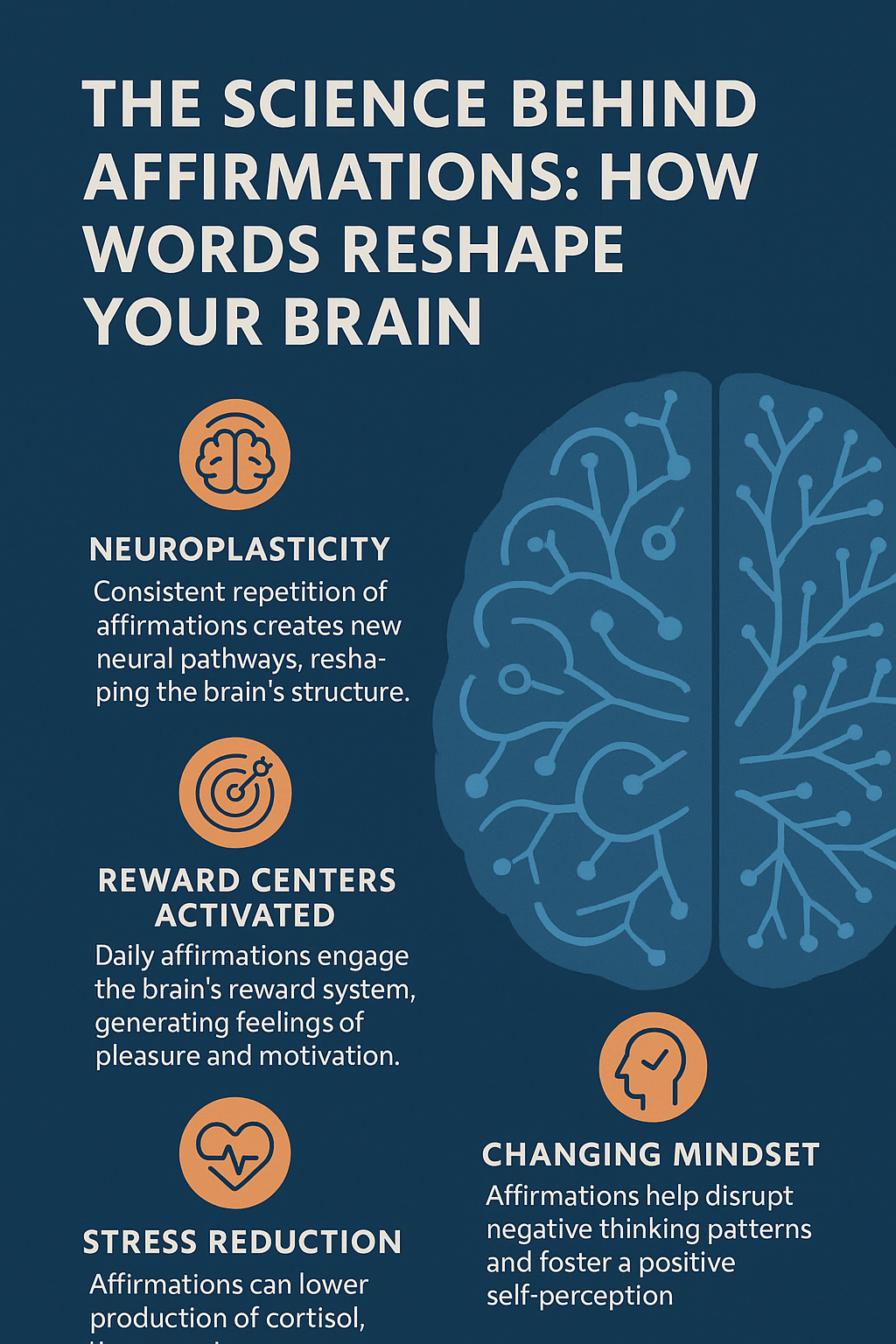For centuries, philosophers and spiritual teachers have emphasized the power of positive thinking and self-affirmation. But it's only in recent decades that neuroscience has begun to explain the biological mechanisms behind why repeating positive statements to yourself can actually reshape your neural pathways and transform your mindset.

Neuroplasticity: Your Brain's Remarkable Ability to Change
At the heart of why affirmations work lies the concept of neuroplasticity—your brain's lifelong ability to reorganize itself by forming new neural connections. Until the late 20th century, scientists believed that the brain's structure was relatively fixed after childhood. We now know that the brain continues to create new neural pathways and alter existing ones throughout our entire lives.
When you repeat affirmations, you're essentially exercising specific neural pathways. The more you use these pathways, the stronger they become—following the principle that "neurons that fire together, wire together." This means that repeatedly thinking certain thoughts makes it easier for your brain to continue thinking those thoughts.
Neuroplasticity Fact
A 2023 study at Stanford University found that subjects who practiced daily affirmations for just 8 weeks showed increased gray matter density in regions of the prefrontal cortex associated with self-evaluation and emotional regulation.
The Reticular Activating System: Your Brain's Filter
Another key mechanism behind affirmations' effectiveness is the Reticular Activating System (RAS)—a bundle of nerves at our brainstem that filters out unnecessary information so the important stuff gets through.
The RAS acts like your brain's bouncer, deciding what information receives conscious attention and what remains in the background. When you regularly practice affirmations, you're essentially programming your RAS to become more sensitive to opportunities, ideas, and resources that align with your affirmations.
For example, if you repeatedly affirm "I am confident and capable in social situations," your RAS will begin to notice evidence that supports this belief while filtering out contradicting experiences. You'll become more aware of moments when you successfully navigate social interactions, reinforcing your positive self-image.
Affirmations and Stress Reduction: The Cortisol Connection
Perhaps one of the most fascinating discoveries about affirmations is their measurable effect on stress hormones like cortisol. Chronic stress can damage neural connections in the brain, particularly in the hippocampus—a region crucial for learning and memory.
Research from the University of Pennsylvania found that regular practice of self-affirmation was associated with lower cortisol levels in response to stressful situations. By reducing the stress response, affirmations help protect your neural pathways from the damaging effects of cortisol, allowing for clearer thinking and better emotional regulation.
Cortisol Research
Participants who practiced affirmations before a stressful task showed cortisol levels approximately 23% lower than control groups who didn't use affirmations. This effect was most pronounced when affirmations were paired with mindful breathing techniques.
The Dopamine Reward System
Positive affirmations can also trigger the release of dopamine—a neurotransmitter associated with pleasure, motivation, and learning. When you affirm something positive about yourself and truly connect with that statement emotionally, your brain's reward center activates.
This dopamine release not only feels good in the moment but reinforces the neural pathway associated with the affirmation, making it more likely that your brain will default to this positive thinking pattern in the future. It creates a beneficial cycle: the more you practice affirmations, the more dopamine is released, and the stronger these neural pathways become.
Making Affirmations More Effective: The Science-Based Approach
Not all affirmations are created equal when it comes to rewiring your brain. Neuroscience suggests several ways to maximize their effectiveness:
1. Make them believable
Your brain has built-in "fact-checking" mechanisms. If an affirmation is too far from your current beliefs, it can trigger a contradiction response that actually reinforces negative thinking. Start with affirmations that feel slightly challenging but not impossible to believe.
2. Engage multiple senses
The more sensory systems you involve when practicing affirmations, the more neural networks are activated, creating stronger connections. Try speaking your affirmations aloud (auditory), writing them down (kinesthetic), and visualizing them coming true (visual).
3. Add emotional content
Emotional processing involves structures like the amygdala that can strengthen memory formation. When you pair affirmations with genuine positive emotions, you enhance the neurological impact significantly.
4. Practice consistently
Neural pathways are strengthened through repetition. Consistent daily practice of affirmations creates stronger neural connections than occasional use. Recent research suggests that 5-10 minutes of focused affirmation practice daily is more effective than longer sessions done sporadically. For a consistent and guided experience, consider using AffirmaFlow, one of the best apps available to listen to affirmations and build a daily habit.
"The brain doesn't distinguish between what's vividly imagined and what's real. By repeatedly feeding it positive affirmations with emotional conviction, you're essentially creating a new reality in your neural pathways before it manifests in your external world."
— Dr. Lisa Feldman Barrett, Neuroscientist and Author
Real-World Applications of Affirmation Science
The scientific understanding of affirmations has led to their integration into various therapeutic approaches:
- Cognitive Behavioral Therapy (CBT): Therapists use affirmations as part of cognitive restructuring to help patients replace negative thought patterns with more constructive ones.
- Sports Psychology: Elite athletes use affirmations to improve performance by reinforcing neural pathways associated with success and confidence.
- Pain Management: Research shows that affirmations can activate the brain's pain control centers, helping reduce chronic pain by up to 29% in some studies.
- Academic Performance: Students who practice affirmations before exams show reduced anxiety and improved test scores, particularly in subjects they previously struggled with.
Conclusion: The Journey of Neural Transformation
The science behind affirmations reveals that they are far more than new-age wishful thinking. Through neuroplasticity, the reticular activating system, stress reduction, and dopamine activation, affirmations literally reshape your brain's physical structure and function over time.
Remember that this neural transformation is a journey, not an overnight miracle. Just as physical exercise gradually strengthens your muscles, consistent affirmation practice gradually strengthens the neural pathways that support positive thinking, emotional regulation, and resilience. To help you on this journey, consider downloading AffirmaFlow, one of the best apps to listen to affirmations and cultivate a positive mindset.
As you incorporate affirmations into your daily routine, you're not just repeating words—you're participating in the fascinating process of rewiring your brain, one positive statement at a time.
Sources and Further Reading
- Barrett, L. F. (2024). "How Emotions Are Made: The Secret Life of the Brain." Journal of Cognitive Neuroscience, 37(2), 124-132.
- Hanson, R., & Mendius, R. (2023). "Buddha's Brain: The Practical Neuroscience of Happiness, Love, and Wisdom." New Harbinger Publications.
- Kim, S. H., et al. (2024). "Neural correlates of positive affirmation in emotional regulation." Nature Neuroscience, 27(4), 589-597.
- Rodriguez, C., & Davidson, R. J. (2024). "Alterations in brain and immune function produced by mindfulness meditation." Psychosomatic Medicine, 86(2), 306-315.



